Temple of Parthenon, at the Acropolis of Athens
Architecture in Greece

The Stadium of Kallimarmaro in Athens

Little Venice in Mykonos, a sample of Cycladic architecture

Many of the worldwide masterpieces were inspired by the architecture of Greece, particularly the ancient Greek style of Doric, Ionic or Corinthian rhythm.
Architecture by periods:
• Minoan • Mycenaean • Classical • Roman • Byzantine • Medieval • Ottoman • Neoclassical
A section about Cycladic architecture was also included.
Ancient Greece has influenced many world architectural movements for centuries, for example, the movement of Renaissance and the Neoclassical style.
In fact, the Neoclassical style that was so popular in the 19th century was actually a revival of ancient greek architecture.
Due to the rich diversity over the centuries, the architectural style is divided into several periods.
You can see samples of all types of architecture with a simple walk in the center of the capital of Greece, even the Cycladic one!
We propose below information about the different periods and styles of architecture in Greece and the Greek islands, from the Minoan times to the modern days.
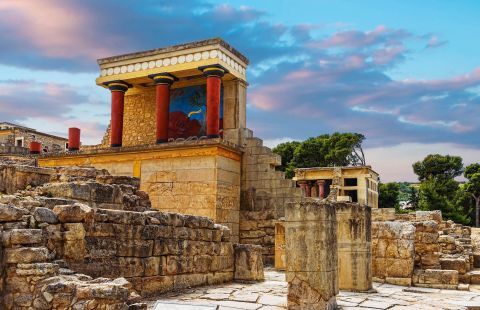
Minoan Architecture
The Minoan civilization (Bronze age) prospered on the Greek island of Crete from the 27th to the 15th century BC.
The most famous architectural achievement of this period is definitely the impressive Palace of Knossos. The palace is situated on a hill and surrounded by pine forests. It is divided into two courts: the west wing, where you can visit the religious and official staterooms, and the East Wing, which was used for domestic and workshop purposes.
Archaeologists have found the wonderful frescoes of Knossos almost untouched, under layers of ash, which leads them to believe that the destruction of the Minoan town of Knossos is probably connected to the huge volcanic eruption of Santorini in about 1,450 BC. These frescoes have vivid colors and represent happy scenes from everyday life and festivities.
These frescoes in combination with the fact that the Minoan towns had no walls show that the Minoans had peaceful relationships with other cultures and did not interfere in wars.
Other important Minoan sites in Crete with beautiful architectural samples are the Palace of Phaestos and the Palace of Zakros.

Mycenaean Architecture
The Mycenaean civilization (Bronze age), which flourished from 1600 to 1200 BC, differs a lot from the Minoan. Unlike the Minoans, whose society was based on trade, the Mycenaean society advanced through warfare.
Mycenae was frequently involved in wars and that is why their towns had so strong and tall walls. These walls took the name Cyclopean because people thought that only Cyclopes could lift the huge stones to build them. The walls of Mycenae and Tiryntha have very characteristic Cyclopean walls.
Very typical of Mycenaen architecture is also the vaulted tombs where the king and high priests were usually buried. In fact, the most famous vaulted tomb is the Treasury of Atreus in Mycenae, which is believed to be the tomb of King Agamemnon.
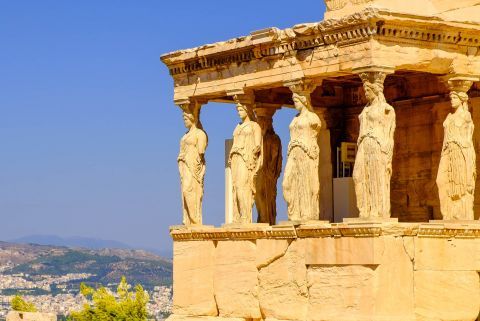
Classical Architecture
Classical architecture in Ancient Greece is the most famous style of architecture of Greece and reveals unique marble temples that were characterized by three different orders:
The austere Doric style, the elegant Ionian style, and the Corinthian style are a mixture of the two previous styles.
All over the mainland of Greece and the Greek islands, there are many ancient temples that were built during the Classical period and are dedicated to various gods:
The temple of Apollo in Delphi, the Temple of Hephaestus in Athens, Athena Aphaia in Aegina, and others.
However, the greatest monument is the Temple of Parthenon, constructed on the sacred site of the Acropolis of Athens.
The Parthenon, built from 447 to 438 BC, is a brilliant example of Doric and Ionian architecture. This octostyle, peripteral temple was dedicated to goddess Athena, the protector of the town, and housed a giant chryselephantine statue of Athena Parthenon, sculpted by Phidias.
The Corinthian style was not so popular in classical times, but still, a very important monument in Athens is made in Corinthian rhythm: The Temple of Olympian Zeus in the city center.
Very typical structures of Classical architecture are also the Ancient Theatres. At first, these theatres were actually places of gathering for people who wanted to take part in a ritual.
For example, during the festivities to honor a god, people would gather in the theatre to take part in the offerings headed by the priest of the god.
With the invention of theatre as an art form, drama performances became part of such religious festivities and thus they were presented in the theatres.
The most typical ancient Greek theatre is the Theatre of Epidaurus, constructed in the 4th century BC and stands out for its perfect symmetry and amazing acoustics.
Other famous theatres are the Theatre of Dionysus, which is considered among the first theatres in the world, and the Theatre of Herodes Atticus, both located at the foot of the Acropolis in Athens.
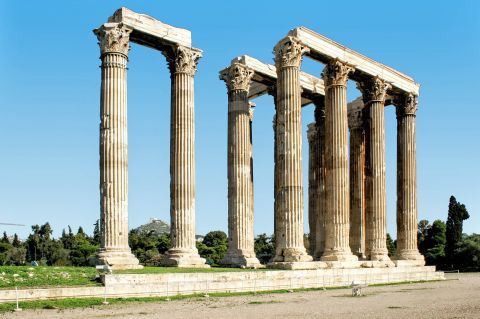
Roman Architecture
In the 2nd century BC, the Romans conquered Greece and marked a new era in architecture.
Roman architecture was actually a mixture of the ancient Greek, Phoenician and Etruscan styles with few influences from other cultures of the Roman empire.
In Athens particularly, there are many structures from the Roman period with characteristic arches and stone carvings of Roman battles.
The Arch of Hadrian, for example, was constructed in 132 AD to mark the borders between the old (classical) Athens and the new (Roman) part of the town.
The Roman Agora and the Library of Hadrian are also important structures and so is the Stoa of Attalos, the first mall in the world.
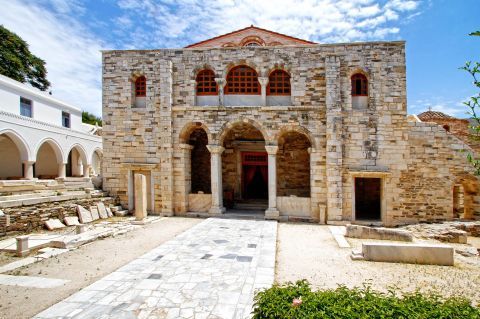
Byzantine Architecture
As the Eastern Roman Empire was gradually transformed into the Byzantine Empire in the 3rd and 4th centuries AD, a new style made its presence in the architecture of Greece.
The Byzantines had a strong religious base and quickly Christianity was made the official religion. Many churches were constructed in the almost 10 centuries that the Empire lasted.
Although the first Byzantine churches had one central aisle and oblong size, then a great innovation appeared: the dome.
The typical Byzantine church, as dominated by time, has a square plan crowned by one or more circular domes. The floor and the churchyard had impressive mosaics, while the walls were decorated with colored frescoes.
The most usual material for the construction of a church was brick.
The most famous Byzantine church is the Church of Agia Sofia in Constantinople, while fascinating Byzantine chapels are found in Mystras, Thessaloniki, Meteora, and Mount Athos.
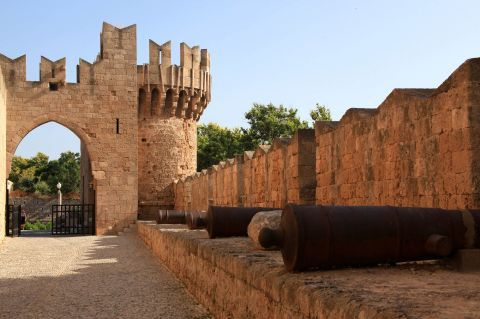
Medieval Architecture
As the Byzantine Empire was starting to fall down in the 12th century BC, Greece was gradually conquered by the Venetians.
Till 1453, when Constantinople fell to the Ottomans, the Venetians had already conquered the western side of the old Byzantine Empire, as the eastern side had been conquered by the Ottomans.
Therefore, almost all mainland of Greece and the Greek islands were at the hand of Venice. The Venetians reconstructed the towns with stone houses, paved streets, and many public buildings.
They also reinforced the ports, as the largest part of the Venetian societies came from trade.
The most famous towns in Greece with some Venetian architecture are the old town of Rhodes, the old town of Naxos, the town of Corfu, the town of Chania, and the town of Rethymno in Crete.
The Venetians had no large army, but they had a very powerful fleet. Their war strategy was to build strong castles that could resist the Turkish or Arabian attacks until help would arrive from the sea. Thus they built huge castles in every strategic part of the mainland and in many islands. Most of these castles underwent few reconstructions over time and survive till today.
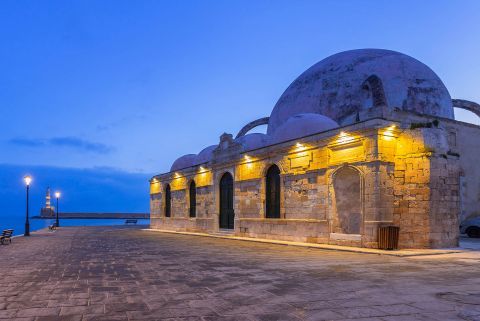
Ottoman Architecture
After the 16th century, almost the entire country fell to the Ottomans, who also left a vivid sign of their architecture in many towns and islands.
Ottoman remains to include mosques, baths, fortification towers, and castles in strategic spots.
Very characteristic Ottoman monuments are the mosques in Kos, Crete, and Rhodes as well as the Ottoman baths in the Old Town of Chania.
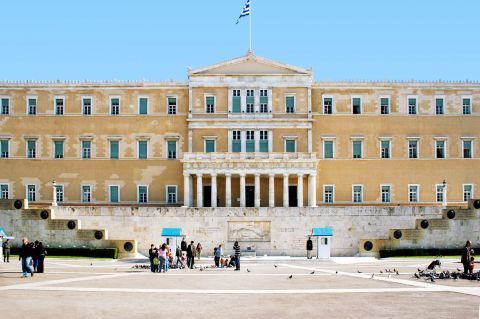
Neoclassical Architecture
The establishment of the modern Greek state in the late 1820s, after four centuries of Ottoman rule, marks a crucial point in the historical course of Greece.
King Otto, the first king of Modern Greece, tried to inspire a new sense of nationalism in the citizens. In this effort to connect the glorious classical past with the present, he made Athens the capital of Greece, ordered to found the modern town of Sparta, and also invited the famous Austrian architect Theophil Hansen to build monuments of Neoclassical style all over Greece, an architectural style that was already flourishing in Europe that time.
Theophil Hansen and his student Ernst Ziller designed many important buildings of Neoclassical Architecture in Greece, including the Neoclassical trilogy in the center of Athens: the Academy, the Library, and the University of Athens. Particularly Ziller traveled all around the country and designed any kinds of buildings, from private houses to town halls, theatres, train stations, and churches.
Among his most famous works is the Presidential Mansion of Athens, the Athens Numismatic Museum which was originally the house of archaeologist Heinrich Schliemann, the Town Hall of Syros, the Apollo Theatre in Patras, the Church of Saint Gregory Palamas in Thessaloniki, the Royal Palace in Tatoi Attica, the train station in Olympia and many others.
The most characteristic features of the Neoclassical style are the symmetrical shape, the tall columns that rise to the full height of the building, the triangular pediment, and the domed roof.
One great example of Neoclassical architecture is the town of Nafplion in the Peloponnese.
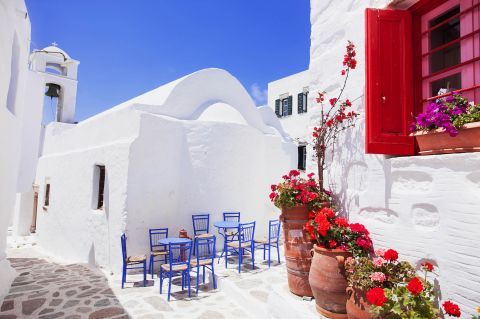
Cycladic Architecture
The Cyclades islands are known for their special architecture. More, it is the ambassador of Greek island architecture.
The local Cycladic architecture has a special interest, highlighting beautiful houses, stone churches, and paved town streets.
The most characteristic feature is the colors: blue and white are the dominating colors in all the islands of the complex.
It is quite an interesting fact that houses were painted in these two colors after a government act. The Greek prime minister Ioannis Metaxas actually ordered, in 1936, the inhabitants of the Cyclades to paint their houses white with blue doors and windows so that these colors match with the blue sky and the white wave foams of Greece.
These two colors are also used for churches, as the walls are painted white and the domes are blue.
The houses in the Cyclades are small and have a rectangular shape with a flat roof, as the strong winds do not allow the construction of triangular roofs. They are built with stones and many of them have flowered yards or gardens.
The inner streets of the villages are narrow and paved, as in the old times all transportation was done on foot or by donkey.
Most capitals in the islands of the Cyclades are called Chora and many of them are built on the back side of slopes so that they were not visible to pirates that used to plunder the Aegean islands till the late 19th century.
One of the most beautiful samples is the village of Oia on Santorini island.
Discover the architecture by location
Discover information about architecture in 90 locations in Greece:





